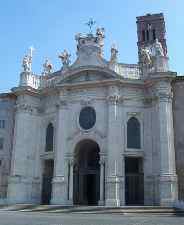
(30K)
472 x 576
| Sunday: Holy Cross in Jerusalem dates to the reign of Emperor Constantine, whose mother, St. Helena converted part of her palace into this church. It is one of the 3 Minor Basilicas of Rome.
|
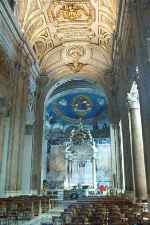
(40K)
434 x 648
| Although renovated in the 18th century, the floor, columns, and bell tower (previous picture) date to medieval times. |
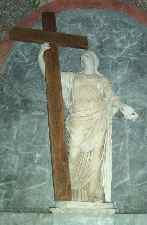
(36K)
426 x 648
| St. Helena, who brought back from the Holy Land a large relic of the true cross, a nail from the cross, and a thorn from the crown of Jesus.
|
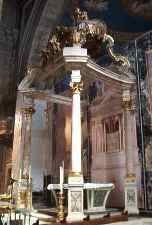
(38K)
438 x 648
| The green basalt altar contains the relics of Sts. Anastasius and Caesarius. Also in this church is believed to be the first part of the INRI sign that Pilate had nailed to the cross (in Hebrew, Greek and Latin). |
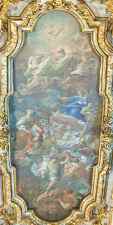
(40K)
364 x 720
| (Ceiling painting) When St. Helena excavated the foot of Mount Calvary and unearthed several wooden beams, how did she know which was the true cross? She placed invalids from Jerusalem on the beams, and when one beam healed the sick, she knew it was the right one.
|
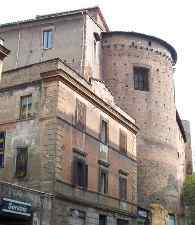
(40K)
500 x 576
| Monday: Santi Quattro Coronati al Celio, quasi-literally: the Four Crowned Saints (in heaven), named after the four martyrs whose relics were brought here from the catacombs. |
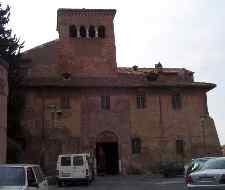
(29K)
648 x 550
| They were four brothers, all Roman officials who were scourged to death under Diocletian for refusing to honor a statute of a pagan God.
|
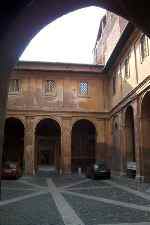
(29K)
434 x 648
| In the middle ages this church and its surrounding Monastery formed the only fortified abbey in Rome, and so was often a temporary papal residence. |
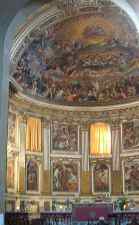
(34K)
432 x 699
| Unfortunately, nothing remains of the original 5th century church. The present structure was built in the ninth century by Leo IV (who brought the relics here) and was greatly remodeled (and reduced in size) in the 12th century by Paschal II.
|
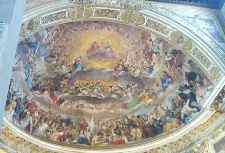
(42K)
648 x 443
| Leo IV was also proclaimed pope here in 847, although there is a legend that this only took place after the true identity of "Pope Joan" was discovered. Historians have discounted the legend as false, but it remains linked to this church. |
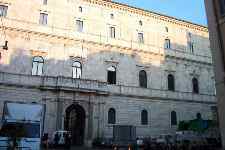
(38K)
645 x 432
| Tuesday: St. Lawrence in Damaso, dedicated to St. Lawrence the Deacon, where Pope Damasus (366-384) built a church over his house, one of the 25 original parishes of Rome.
|
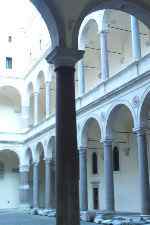
(29K)
434 x 648
| In 1484 the basilica and palace were demolished to build the present Renaissance palace, which is still owned by the Vatican and houses many offices of the Roman Curia. |
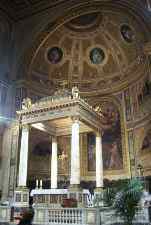
(40K)
436 x 648
| The present Renaissance church was incorporated into the new palace. The high altar is a work of Bernini, under which are the remains of Pope St. Damasus and other saints and martyrs.
|
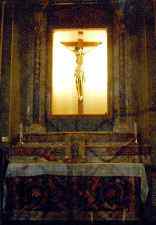
(35K)
450 x 648
| This 14th century crucifix is said to be miraculous, and St. Bridget of Sweden often prayer here while she lived in Rome. |
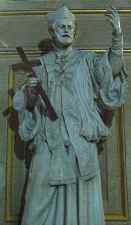
(36K)
422 x 720
| A nice statue of St. Ignatius of Loyola in the Vestibule.
|
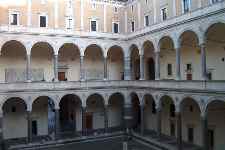
(40K)
720 x 482
| Inside the new Palazzo, with its beautiful courtyard. Since the 16th century it has housed the offices of the papal chancery, thus its name, the Cancelleria. |
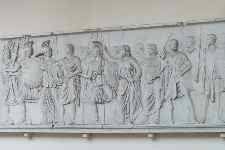
(31K)
634 x 423
| A few reminders that this was where Pope Damasus, besides constructing the Church of St. Lawrence, also erected here a public library.
|
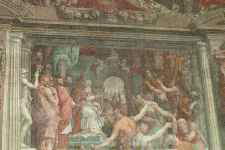
(41K)
720 x 481
| The walls inside the Palazzo are covered with beautiful frescos of various Cardinals. |
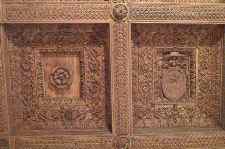
(52K)
648 x 431
| With intricately carved wooden coffered ceilings.
|
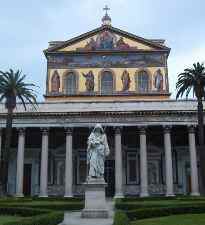
(37K)
527 x 576
| Wednesday: St. Paul outside the Walls on the Ostian Way, where St. Paul was buried after his martyrdom in the persecution of Nero (64-67). |
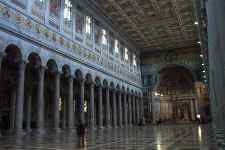
(34K)
648 x 434
| The largest church in Rome after St. Peter's Basilica, it was originally constructed in the 4th century and by the 8th century became the largest and most beautiful church in Rome, surpassing even St. Peters.
|
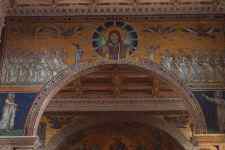
(37K)
720 x 482
| On July 15th, 1823 the roof caught fire and crashed into the nave and aisles, destroying most of the basilica except the apse. So here the 4th century mosaic by Pope Theodocius still remains. (The reconstructed Basilica retains the same size and plan of the one destroyed.) |
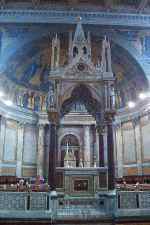
(40K)
434 x 648
| The beautiful Gothic baldachin above Paul's tomb from the 13-14th century, the statues in the 4 corner niches are Peter, Paul, Timothy and Bartholomew, the abbot who commissioned it.
|
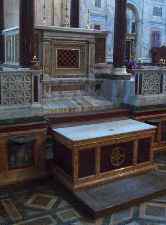
(38K)
480 x 648
| The confessio, where under the main altar is the Apostle's tombs. During rebuilding after the fire, a part of the first-century tomb was uncovered. A marble slab with the inscription Paulo Apostolo Mart covers it. |
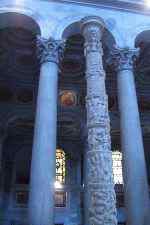
(31K)
434 x 648
| This incredible Easter candlestick is about 18 feet tall and dates from 1170, with carved scenes from Christ's passion and ascension. Notice in the background the picture of Pope John Paul II is lit up - the Basilica contains representations of all 265 popes!
|
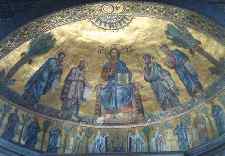
(44K)
648 x 450
| The apse mosaic dated from around 1220 and also survived the fire. Christ sits as a majestic teacher as his hand is raised in blessing. Sts. Paul and Luke are on his right, Peter and Andrew on his left. The apostles below them each hold scrolls with the words of the Gloria which is sung at mass. Notice all the palm trees in paradise! |
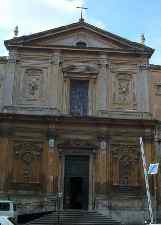
(35K)
465 x 648
| Thursday: St. Martin ai Monti, the origins of this Church date back to the imperial persecutions, where this was a secret house church. A church was then built here by Pope St. Sylvester (4th century) dedicated to St. Martin of Tours.
|
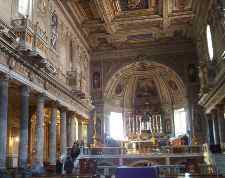
(41K)
576 x 458
| Important in Church History, this Church was site for the preparatory meeting for the Council of Nicea in 325, and afterwards, it was here that the Nicene Creed was first proclaimed in Rome. (And here the heretical books of Arius were burnt.) |
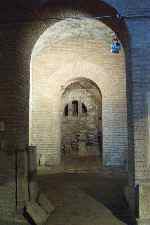
(34K)
434 x 648
| In the excavations under the Church of the original house church, looking very much like other Roman houses at its time.
|
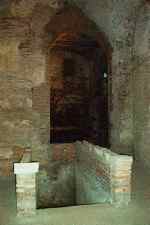
(28K)
434 x 648
| With one exception, a large vaulted room appears to have been built to hold about 400 people! Such an assembly hall / sanctuary is the only known to exist of this type. |
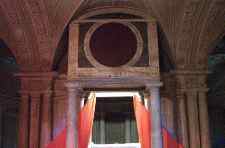
(29K)
649 x 429
| In the 9th century, the relics of many martyrs were brought from the catacombs of St. Priscilla, encased here in the crypt.
|
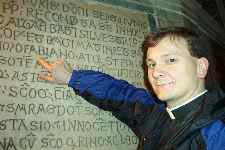
(92K)
864 x 579
| The inscription lists the relics here, including St. Sylvester and many other Popes, including Fabian, Sergius, Stephan I and Innocent I among many others which the inscription says "are known only to God." |
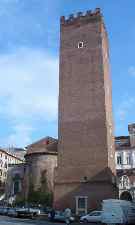
(34K)
391 x 648
| As one approaches (or leaves) St. Martins, a large tower sits in the middle of the square. (The church is on the left.)
|
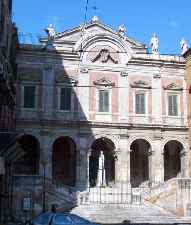
(42K)
490 x 576
| Friday: St. Eusebius, site of the home of this heroic Roman priest, who condemned to death by starvation by the Arian Emperor Constantinus in 357. |
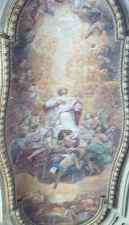
(28K)
374 x 648
| (Ceiling painting) His home was converted in one of the 25 original parishes of Rome. From early times the Church has also honored here 3 deacon martyrs: Sts. Stephen (Jerusalem), Lawrence (Rome), and Vincent (Spain).
|
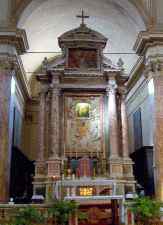
(30K)
472 x 648
| The church was reconstructed in 1238 by Gregory IX. The relics of St. Eusebius are under the high altar. |
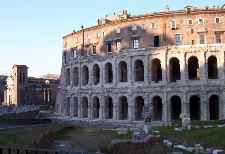
(38K)
648 x 446
| Saturday: Approaching St. Nicholas (left side), one passes the impressive Theater of Marcellus, and notices the many other Roman ruins which surround the Church.
|
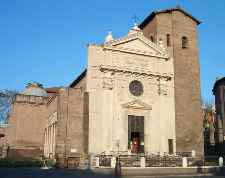
(37K)
648 x 515
| The Church was built out of three Roman temples (about 165 BC). It is on top of one with the other two incorporated in the outer walls. (Notice the pillars which make up the left exterior wall here.) |
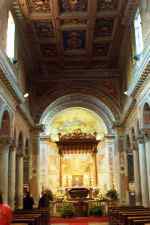
(26K)
434 x 648
| Probably built in the 6th century (and remodeled in 1599), the columns were taken from the pagan temples. The urn under the altar contains the remains of Sts. Marcellinus, Faustinus, Simplicus and Beatrice.
|
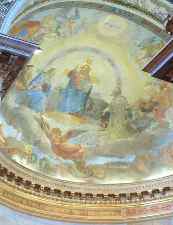
(39K)
501 x 648
| The Church is dedicated to St. Nicholas in Prison, perhaps because St. Nicholas is the patron of prisoners, or recalling how he was imprisoned: once by the Emperor during the Roman persecution, and once during the Council of Nicea after he attacked Arius with more than just words.
|
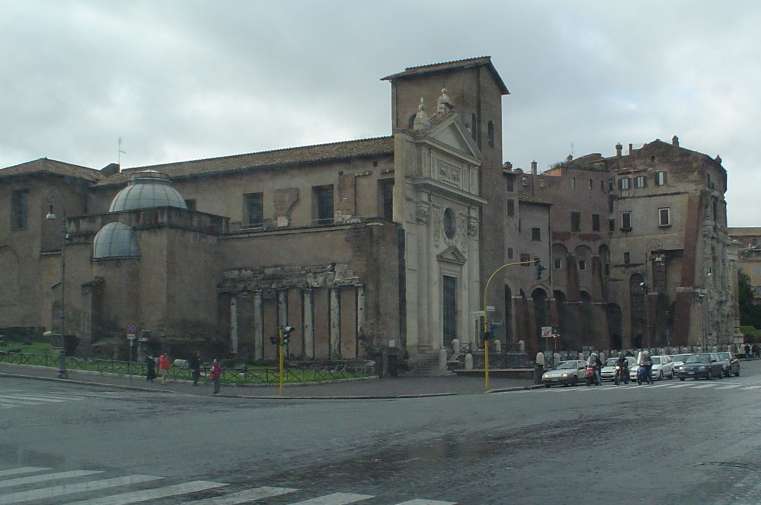
Another view of St. Nicholas and the ruins which surround and make up the Church. | |







































